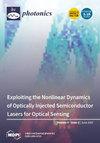Simulation Study on Tunable Terahertz Bandpass Filter Based on Metal–Silicon–Metal Metasurface
IF 2.1
4区 物理与天体物理
Q2 OPTICS
引用次数: 0
Abstract
Metasurface devices have demonstrated powerful electromagnetic wave manipulation capabilities. By adjusting the shape and size parameters of the metasurface microstructure, we can control the resonance between spatial electromagnetic waves and the metasurface, which will trigger wave scattering at a specific frequency. By utilizing these characteristics, we design a metasurface device with a bandpass filtering function and a unit cell of the metasurface consisting of a double-layer pinwheel-shaped metal structure and high resistance silicon substrate (forming metal–silicon–metal configuration). A bandpass filter operating in the terahertz band has been implemented, which achieves a 36 GHz filtering bandwidth when the transmission amplitude decreases by 3 dB and remains effective in a wave incidence angle of 20°. This work uses an equivalent RC resonance circuit to explain the formation of bandpass filtering. In addition, the photosensitive properties of silicon enable the filtering function of the device to have on/off tuned characteristics under light excitation, which enhances the dynamic controllability of the filter. The designed device may have application prospects in 6G space communication.基于金属-硅-金属金属表面的可调谐太赫兹带通滤波器仿真研究
元表面装置已显示出强大的电磁波操纵能力。通过调整元表面微结构的形状和尺寸参数,我们可以控制空间电磁波与元表面之间的共振,从而引发特定频率的波散射。利用这些特性,我们设计了一种具有带通滤波功能的元表面器件,元表面的单元单元由双层风车状金属结构和高电阻硅衬底(形成金属-硅-金属构型)组成。实现了太赫兹波段的带通滤波器,当传输振幅降低 3 dB 时,滤波带宽达到 36 GHz,并且在波入射角为 20° 时仍然有效。这项工作使用等效 RC 谐振电路来解释带通滤波器的形成。此外,硅的光敏特性使该器件的滤波功能在光激励下具有开/关调谐特性,从而增强了滤波器的动态可控性。所设计的器件可能在 6G 空间通信中具有应用前景。
本文章由计算机程序翻译,如有差异,请以英文原文为准。
求助全文
约1分钟内获得全文
求助全文
来源期刊

Photonics
Physics and Astronomy-Instrumentation
CiteScore
2.60
自引率
20.80%
发文量
817
审稿时长
8 weeks
期刊介绍:
Photonics (ISSN 2304-6732) aims at a fast turn around time for peer-reviewing manuscripts and producing accepted articles. The online-only and open access nature of the journal will allow for a speedy and wide circulation of your research as well as review articles. We aim at establishing Photonics as a leading venue for publishing high impact fundamental research but also applications of optics and photonics. The journal particularly welcomes both theoretical (simulation) and experimental research. Our aim is to encourage scientists to publish their experimental and theoretical results in as much detail as possible. There is no restriction on the length of the papers. The full experimental details must be provided so that the results can be reproduced. Electronic files and software regarding the full details of the calculation and experimental procedure, if unable to be published in a normal way, can be deposited as supplementary material.
 求助内容:
求助内容: 应助结果提醒方式:
应助结果提醒方式:


